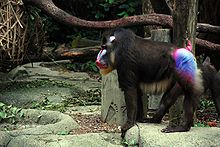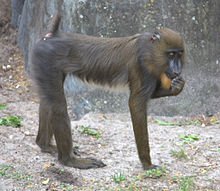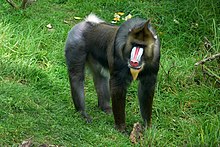The mandrill (Mandrillus sphinx) is a primate of the Old World monkey (Cercopithecidae) family. It is one of two species assigned to the genus Mandrillus, along with the drill. Both the mandrill and the drill were once classified as baboons in the genus Papio, but they now have their own genus, Mandrillus. Although they look superficially like baboons, they are more closely related to Cercocebus mangabeys. Mandrills are found in southern Cameroon, Gabon, Equatorial Guinea, and Congo. Mandrills mostly live in tropical rainforests. They live in very large groups. Mandrills have an omnivorous diet consisting mostly of fruits and insects. Their mating season peaks in July to September, with a corresponding birth peak in December to April.
Mandrills are the world's largest monkeys. Charles Darwin wrote in The Descent of Man that "no other member in the whole class of mammals is coloured in so extraordinary a manner as the adult male mandrill's".The mandrill is classified as vulnerable by IUCN.
The mandrill has an olive green or dark grey pelage with yellow and black bands and a white belly. Its hairless face has an elongated muzzle with distinctive characteristics, such as a red stripe down the middle and protruding blue ridges on the sides. It also has red nostrils and lips, a yellow beard and white tufts. The areas around the genitals and the anus are multi-colored, being red, pink, blue, scarlet, and purple. They also have pale pink ischial callosities. The coloration of the animal is more pronounced in dominant adult males. Both sexes have chest glands, which are used in olfactory communication. These, too, are more prominent in dominant adult males. Males also have longer canines than females, which can be up to 6.35 cm (2.50 in) and 1.0 cm, respectively.
The mandrill is considered vulnerable and is affected by deforestation. However, hunting for bushmeat is the more direct threat. Mandrills are particularly threatened in the Republic of the Congo. Nevertheless, there have been captive-bred individuals that have been successfully reintroduced into the wild.



Hi! I am a robot. I just upvoted you! I found similar content that readers might be interested in:
https://en.wikipedia.org/wiki/Mandrill
Downvoting a post can decrease pending rewards and make it less visible. Common reasons:
Submit